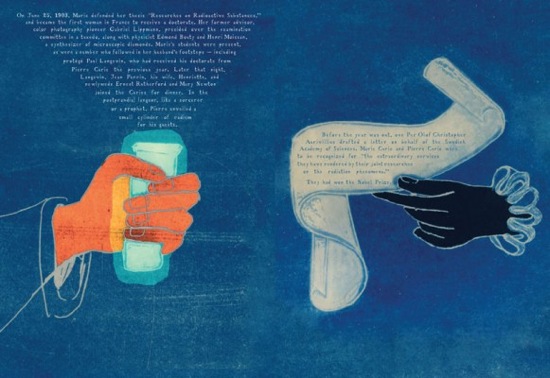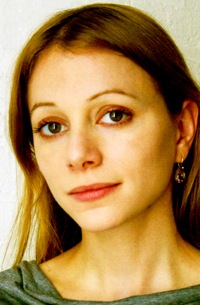Go Big Read author to visit UW campus

The pages of “Radioactive,” this year’s Go Big Read selection, are richly illustrated.
“Radioactive” is inspiring discussions about the life and work of Marie Curie, but also the form and genre of the innovative book itself.
What is this year’s Go Big Read selection, exactly? A biography? A science book? A graphic novel? Readers from the University of Wisconsin–Madison community are not the first to ponder these questions about “Radioactive:Marie and Pierre Curie, A Tale of Love and Fallout,” selected for the university’s common-reading program.
Author Malcom Gladwell says it is “unlike any book I have ever read … sheer imaginative genius.”

Redniss
Lauren Redniss, the author and illustrator of “Radioactive,” will shed light on her book when she comes to campus Monday, Oct. 15 for a public talk and a question-and-answer session moderated by Interim Chancellor David Ward.
The event begins at 7 p.m. in Varsity Hall at Union South. It will be streamed live, captioned and archived for later viewing on the Go Big Read program website.
During her two-day visit to campus, Redniss will also meet with students, including those from first-year writing courses and seminars, First-Year Interest Groups, residential learning communities, the Integrated Studies in Science, Engineering and Society Undergraduate Certificate Program and the Women in Science and Engineering Leadership Institute.”
“It’s funny — for me, it doesn’t feel unconventional; it feels like a natural way to handle the material,” Redniss said in a recent interview with The Badger Herald. “But I can understand why other people use that label, because most books don’t rely on images primarily to tell non-fiction stories to adult audiences.”
More than 5,000 new students received copies of “Radioactive” during Wisconsin Welcome in August, and a record number of UW courses — more than 90 — are using it this semester. Robin Valenza, an associate professor of English, included the book in her popular class, The Graphic Novel.
“You have to talk about style when you talk about this book,” Valenza says, noting its blend of collage, photograph and cyanotype printing.
Valenza says the book is a cross between something you would find in a library and in a museum. She classifies “Radioactive” as an “artist’s book,” a tradition with founders including William Blake, the noted poet, artist, and bookmaker.
“It’s a book designed as a work of art,” Valenza says. “Graphic novels may sometimes also fall into that category.”
While “Radioactive” is not a graphic novel, she says, it does share key characteristics of one, such as putting text and images together in complicated ways for adults. “Maus” by American cartoonist Art Spiegelman, considered a classic of the genre, depicts his father’s story of surviving the Holocaust in comic form, depicting Jews, Germans, Poles, French and Americans as different animals. “Maus,” along with “The Watchmen” and “Batman: The Dark Knight,” were a trio of books that cemented literary respectability for graphic novels in the mid-1980s.
“The term ‘graphic novel’ became common so people knew you were not talking about children’s books,” Valenza says.
Valenza says her students found “Radioactive” haunting because, as they moved through the book and read about radiation and its effects, the pages took on “a glowing life of their own.” Later in the semester, students will have the option to create their own graphic novels inspired by one of the books they have read in the class, including “Radioactive.”
“It’s an exciting book,” Valenza says.
Tags: events, Go Big Read




